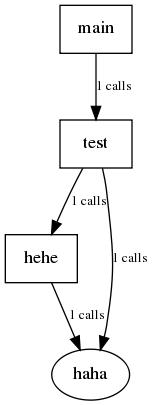最近在想怎么把一个程序的函数调用关系快速的用流程图的方式画出来,之后看到了这个一篇文章“用 Graphviz 可视化函数调用”(http://www.ibm.com/developerworks/cn/linux/l-graphvis/)感觉不错,详细的原理请看原文章,这里只把我的实验过程记录下,以备自己以后的不时之需。
1、要有代码,随便写个小程序,如下所示。
#cat test.c
#include <stdio.h> #include <string.h> void haha(); void hehe() { printf("int hehe "); haha(); } void test() { printf("hehe test "); hehe(); haha(); } void haha() { printf("in haha "); } int main() { test(); printf("hello world ! "); return 0; }
2、要下载一个叫pvtrace的解析工具,我把它放到了百度网盘上:http://pan.baidu.com/s/1sj23YPJ
这个工具解压后的文件如下
# unzip pvtrace.zip
[root@localhost pvtrace]# ls
instrument.c Makefile stack.c stack.h symbols.c symbols.h trace.c
之后编译、安装
[root@localhost pvtrace]# make gcc -Wall -c trace.c gcc -Wall -c symbols.c gcc -Wall -c stack.c gcc -o pvtrace trace.o symbols.o stack.o [root@localhost pvtrace]# make install cp pvtrace /usr/local/bin
3、把pvtrace目录下的instrument.c文件放到你的项目下
# ls
instrument.c Makefile test.c
修改Makefile,编译test.c的时候把这个源文件加上。还有就是在编译选项中加上这个参数 -finstrument-functions
编译自己的项目:
# make gcc -g -c -o test.o test.c -I../../include -g -finstrument-functions gcc -g -c -o instrument.o instrument.c -I../../include -g -finstrument-functions gcc -g -o test test.o instrument.o -L./
4、现在开始生成函数调用的流程图了
运行自己的项目test
# ./test
注:这里有个问题是你的程序运行多少,它记录多少函数之间的关系。你运行的少,它就记录的少,运行的多久记录的多。也就是说,那些暂时没有运行的代码,是不能被记录的。这个在原文章中有说明,因为人家记录的时候就是在运行的时候记录的嘛。
运行完成后会生成一个叫做trace.txt的文件
# ls
instrument.c instrument.o Makefile test test.c test.o trace.txt
接下来使用pvtrace解析这个文件,但是pvtrace后面跟的参数不是trace.txt,而是我们的程序test
[root@localhost drawFuncPic]# pvtrace test
[root@localhost drawFuncPic]# ls
graph.dot instrument.c instrument.o Makefile test test.c test.o trace.txt
生成了gaph.dot文件,接下来就是使用Graphviz的dot工具,把这个graph.dot变成一个图片了。
[root@localhost drawFuncPic]# dot -Tjpg graph.dot -o graph.jpg
[root@localhost drawFuncPic]# ls
graph.dot graph.jpg instrument.c instrument.o Makefile test test.c test.o trace.txt
注:没有Graphviz的话可以去官网下载或者使用命令“#yum install graphviz”进行安装:
# yum install graphviz Loaded plugins: fastestmirror, security Loading mirror speeds from cached hostfile * base: mirrors.btte.net * extras: mirrors.yun-idc.com * updates: mirrors.opencas.cn Setting up Install Process Package graphviz-2.26.0-10.el6.x86_64 already installed and latest version Nothing to do
我这里有一个安装graphviz的笔记:http://www.cnblogs.com/fengbohello/p/4689131.html
生成的流程图如下:

参考:
http://www.ibm.com/developerworks/cn/linux/l-graphvis/
http://blog.sina.com.cn/s/blog_67fcf49e0101m9r0.html
http://download.csdn.net/download/u011843461/8389925